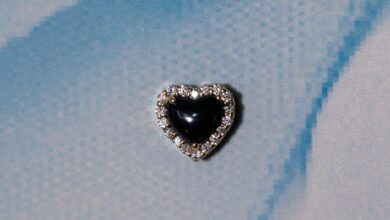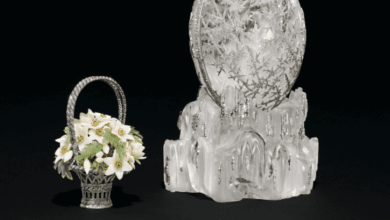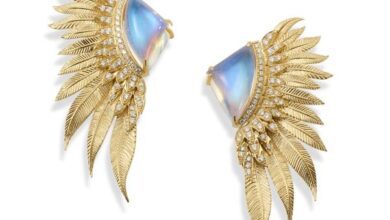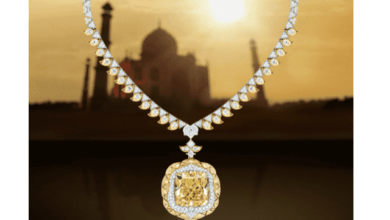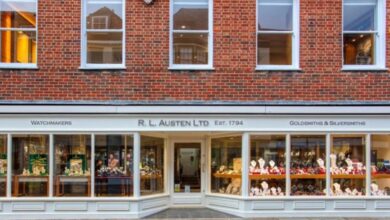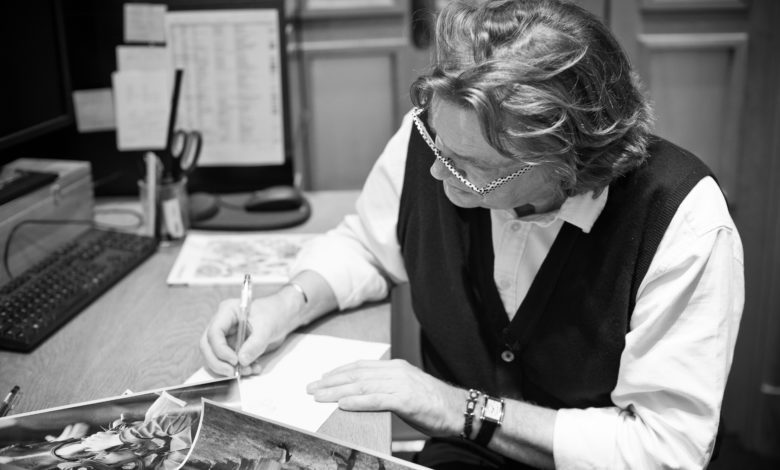
Register to get 1 free article
Reveal the article below by registering for our email newsletter.
Want unlimited access? View Plans
Already have an account? Sign in
We caught up with London-based jewellery designer THEO FENNELL, whose flamboyant pieces caught the eye of one Elton John decades ago. Here, he ruminates on what it takes to be successful, and how the industry has changed.
Give us a potted history of your career and how you got to where you are?
I left art school in the early 70s with a vague idea of doing something creative, but I didn’t have jewellery in mind. I was doing portraiture, as there was almost no jewellery at art school in those days – there simply were not many positions available for jewellery designers. I suppose now there are about 7,000 times more jewellery designers than there were back then. In those days it certainly wasn’t a career path I’d even thought of, but I left art school and was looking for a job, so I ended up going to work for some silversmiths in Hatton Garden .
I knew nothing about silversmithing or jewellery, and it never occurred to me in a million years that that is what I would end up doing, but I embraced the whole idea of craftsmanship, I loved the idea of the traditions involved and I found the whole spirit of designers working with craftsman and no-one being more important than anyone else to be brilliant. They had incredibly arcane skills of stone-carving and engraving and enamelling, a real power house of traditional skills. Naturally, while I was there I started to become interested in jewellery, started to design a few pieces for friends, they started to buy them and that’s what happened.
How many years did you spend learning the first set of skills after art school?
The first set of skills was understanding what could be made, how it could be made, and what was practical. Those are the things you need. If you’re going to design jewellery, you really must know about stones and metals. I think nowadays this idea that people can just come in, do a scribble and say ‘make that’ is flawed. What they’re really offering are only vague pointers to a craftsman. I don’t call that jewellery design; I call that editing.
Do you think there’s an element of ‘the architect’ in the jewellery design process?
There’s no doubt. You can have an idea and just say, ‘somebody run with that’, but it’s no different from saying ‘I’ve got a great idea for a film, ‘man murders woman, and then leave it to you to do the rest’. But if you’re genuinely doing jewellery design as a discipline, then you have to know what is practical. For example, it has to fit the wearer; the number of times I’ve seen very expensive necklaces which simply don’t. It’s like having teapots that don’t pour. There’s a practical consideration as well as a design and aesthetics one, which takes a long time to learn. I’m a great believer in those disciplines.
You mention a ‘profusion’ of people wanting to become designers nowadays. What does the future hold for them?
I do a lot of work with students, at the Royal College and Central Saint Martins and various other places, and quite often I’m the sort of harbinger of bad news because I’m saying ‘you must have these disciplines and you must be practical’. Students often have this view that the golden art school days will last forever, and they are slightly disillusioned when they come out and realise the industry is vastly oversubscribed. So you either have to be very dedicated or very tenacious, and/or very good (preferably all of those things) to get by. So I think people are learning these trades and these crafts need to understand concurrently the economics involved, otherwise you’re going to end up with that teapot costing £200,000 and not pouring. Or a necklace that’s taken two years to build.
There are vast amounts of people going to art school, a profusion of them thinking they can do it (as I did – I’m not saying it’s an ignoble cause), but there simply aren’t that many jobs or positions for creative and original thinkers. If you don’t find a job or a way of making a living within that then it is very disappointing. It’s very difficult to ‘half do’ or ‘partway do’ something like this – you’re going to find yourself facing a fairly banal existence.
Aside from the design talent, what about the challenges of actually starting a business to sell these wares?
It’s not regret, but when I first started on my own, I wish I’d known more about business. But there was no way of doing it then – now there is the internet, there are all sorts of helpful organisations, there are colleges that are much more pragmatic than they used to be, helping people get internships and work experience instead of being entirely artsy fartsy. I always feel a little bit like the boring old fart of an uncle coming around to these places [with realist advice] because I don’t want to lower the enthusiasm.
So you’re trying to help people avoid thinking that the dream is enough?
The dream has got to be very strong, you’ve got to knock on a lot of doors and you’ve got to be very lucky. And I think the obsession with starting up on your own with your own business and brand is the same is like saying you want to be a star. It’s like saying ‘I want to go into the theatre but only if I can be the star’. You’ve got to do your time. There is this umbrella name of ‘jeweller’ which includes everything from a feather on the end of a piece of string all the way through to a Faberge objet. They’re not the same thing at all, except in that you can say the scribblings of a child are at the other end of the spectrum from a Da Vinci.
How do you think the world of jewellery changed over the years?
Jewellery is a weird thing in that where people were unbelievably conscientious about saying that something is gold plaited or silver plaited, but now they just say ‘gold earrings’, and you’re thinking ‘Woah, that’s a loose definition’. There’s a huge amount of costume jewellery out there posing as real jewellery. I think in my mind, there’s the type of jewellery that finds its way into a shoebox, and every girl has it. As she gets older, the shoebox gets fuller. A lot of jewellery that’s around now will end up in that shoebox – that is costume jewellery, however expensive it is.
I think one of the problems of branded jewellery is that it’s very expensive for what it is and it doesn’t come from the heart, it comes from the boardroom table. What a brand does is mean that you can sell something not that original for a lot of money, many times. There is a level at which something which is as available as that loses its sparkle, so to speak. It seems to me a strange contradiction that things you can buy in every airport or high street around the world are somehow ‘special’, and there is a big difference between expensive jewellery and good jewellery.
The interesting thing is that when branding first kicked off, anyone who had a name for anything whether it was making suitcases or frocks got on the jewellery bandwagon, because they thought: ‘How expensive can a pair of shoes be, but my god how expensive can a piece of jewellery be?’ The answer was ‘we’ve taken the ceiling away’. Suddenly there was a profusion of jewellery everywhere. But among the cognoscenti 100 years ago; there was this ubiquity of thought that jewellery must be something extremely special. Objects would forever be known as ‘the Princess Fatima brooch’ for example. They loved the idea of superb design, brilliant craftsmanship, but since then billions of pounds of advertising has diluted it so that all you need is a big name. These people a century ago would have been mortified to wear a piece that had somebody’s name on it.
With the rapid growth in emerging markets, what do you the effect has been on the jewellery industry?
In the 1970s the money only really came from two or three sources. Now the emerging markets are having the required effect, in that people are becoming patrons of jewellers again. Many people thought customers from the emerging markets would be naïve, but actually they are much more sophisticated than anyone expected. Especially with China and India, and the South American market – these people are inclined to have really nice things. One of the positive effects of this is that all the big brands are suddenly trying to re-establish their credentials as craftspeople, so suddenly you see incredibly good looking cobblers in shop windows making shoes claiming ‘handmade above our shop’. In reality it doesn’t exist, but the trend is driving people back to this idea of having handmade nice things.
How did you finance getting started in the early days?
We didn’t. We had no money. From the first time I went on my own from 1975 it was the most unbelievable struggle. It must have been 50 times I said, ‘this is mad, I should give up’. Things like having to head to the pawnbrokers with my cufflinks to pay the wages on a Friday give a flavour of how tough it was. Running this type of business is very capital intensive and it was very tough in the early days.
The modern culture is that young people want to start a company and become a millionaire overnight. What keeps you going at when it’s such a struggle?
The reality is that once you’ve made a couple of mistakes and you realise you should have taken some advice, a certain level of bloody-mindedness comes in, and pride becomes a big factor. What people did say to me at the time was ‘work for another business, get the skills, do the hard work’. To be honest, if I had done five more years at the coal face, it would have saved me 15 of really tough times. Back then it was a case of once you’re on your own, you’ve got no-one to ask.
So you were in an environment where it was harder to start, but also entering a less mature market?
It was so much more unusual – there was no entrepreneurs club, and there was no internet. Getting your name out there was unbelievably complicated. So little was written in the papers about products or companies – nowadays the cross over between company news and actual news is much greater. There were also about a fiftieth of the magazines that there are now. These days, advice is pretty easy to come by, it is more freely available. Most people know people in business, and it is worth seeking out that guidance. Today I think there is much less stigma attached to failing, much less of the ‘what a w****r’ reaction from spectators. People say ‘Oh I’ve had nine businesses now’, and even on the 10th no-one says ‘perhaps you should give it up’.
Elton John has been a patron of yours for many years. To what extent did that help your career to gain traction?
In the old days you had craftsmen, you had designers, and you had jewellers. Being a jewellers was all-encompassing. If you were to say ‘I’m going to a jewellers’, you would not be talking about a brand, you would be talking about a jeweller who owned a shop and who over the years had built up a clientele where he knew what they liked. He was the family jeweller, a family company in the high street.
He occupied a position of huge trust. He would try and find pieces from wherever; some modern, some antique that he could offer to his clients. In those days, they just wanted a piece that they really liked, not necessarily from a brand. No-one would ever say I’m going to get an ‘X’ engagement ring. For the middle classes down, they would go to family jewellers.
We were very early in not being family jewellers. When we started in 1982 in a shop just up from here on the Fulham road, we only did 18ct gold, and the vast majority of gold in this country at that time was 9ct. We only did our own jewellery; we did an awful lot of semi-precious stones like tanzanites and tourmaline way before other people were using them, so it was a very rare beast, but now it doesn’t seem very unusual. At that time, we hadn’t a client in the world, except friends and friends of friends. We just opened the doors and I don’t really know what we thought was going to happen.
Anyway, we were very cheery and we knew a lot of people. I went to every party I could go to, as we had to take the shop window to the people we were aiming at. In those days had to physically to get out and meet people as much as you could and it was a bit of a grind. We knew some people who were starting out at the same time as us, and they weren’t that well off but started to do well in the music industry or writing or whatever else. One of the most important of those to us was Elton John.
We had people who spent more, bought more, but what Elton did and still does to people was really appear in the guise of a mentor or patron. He would say, ‘I love what you do’, but ‘you can go up a gear for me and I’ll still have it’. This allowed me to do things that I wouldn’t have been able to afford to do.
This article first appeared in the January 2014 edition of Jewellery Focus. Interview by Michael Northcott.
[ot-gallery url=”https://www.jewelleryfocus.co.uk/gallery/theo-fennell-interview-2″]


